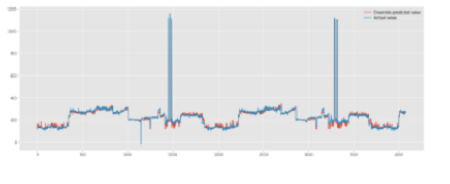


Indian Journal of Science and Technology
Year: 2021, Volume: 14, Issue: 43, Pages: 3227-3236
Original Article
Anagha D Ananth1, Sujatha Arun Kokatnoor2*
1Student, Department of Computer Science and Engineering, CHRIST (Deemed to be University), Bangalore, 560074, India
2Assistant Professor, Department of Computer Science and Engineering, CHRIST (Deemed to be University), Bangalore, 560074, India
*Corresponding Author
Email: [email protected]
Received Date:05 February 2021, Accepted Date:21 November 2021, Published Date:21 December 2021
Objectives: To design and develop an enhanced ensemble model for residential energy consumption prediction using time series analysis. Methods: The system is consistent of an ensemble made from two time series models, which are later combined to produce a final prediction through the use of bagging techniques. The energy profile is built for this study using the data collected from a single-phase Minion Energy Monitor, installed in residential buildings, which is developed by Minion Labs India Private Limited. Samples are collected for a time of 7 days with a two second interval. This data is then restructured and normalized for it to fit the enhanced ensemble model of Long Short-Term Memory (LSTM) and Vector Autoregression (VAR) using bagging techniques and weighted average to obtain the predictions.Findings: The proposed model has produced an enhanced R2 score of 98.99% when compared to LSTM (74.85%), SVM (62.41%), VAR (82.914%) and ARIMA (93.152%) standalone models. It makes use of an analyzed lag variable to reduce computation complexity and resource utilization. Further, an ensemble technique is used to pick out the strengths of two models. An analysis performed showed that this architecture is 6.08% better than the algorithms for LSTM and VAR individually. Novelty: A data driven solution is proposed in this study through the enhancement of existing models to create an ensemble and thereby creating a stable structure that predicts values using a weighted average. The weighted average ensures that precise outputs are obtained by giving more importance to predictions that are closer to the actual values. The use of a lag variable further increases the efficiency, learning rate, dealing with non-linear features, less error and faster training of the proposed architecture. All these factors also aid in improving the accuracy for a time series data prediction.
Keywords: Energy Consumption Forecast; LSTM; VAR; Ensemble; Bagging; Artificial Neural Networks; Support Vector Machine
© 2021 Ananth & Kokatnoor. This is an open-access article distributed under the terms of the Creative Commons Attribution License, which permits unrestricted use, distribution, and reproduction in any medium, provided the original author and source are credited. Published By Indian Society for Education and Environment (iSee)
Subscribe now for latest articles and news.